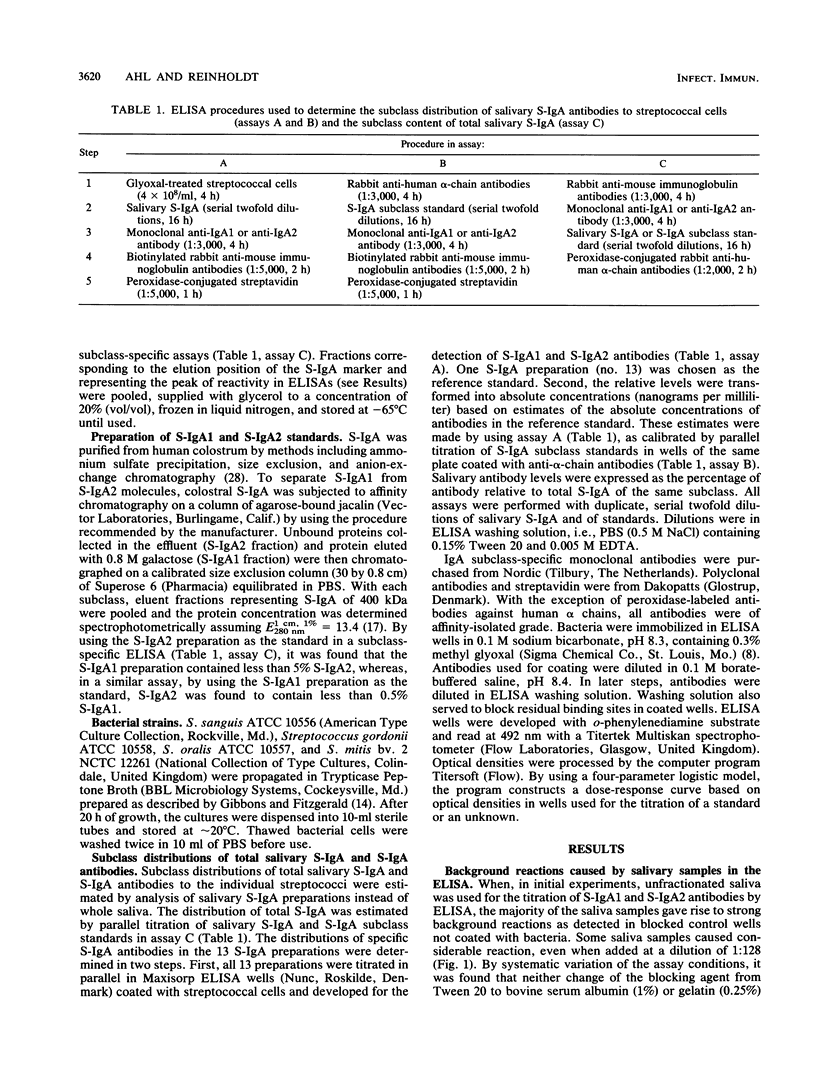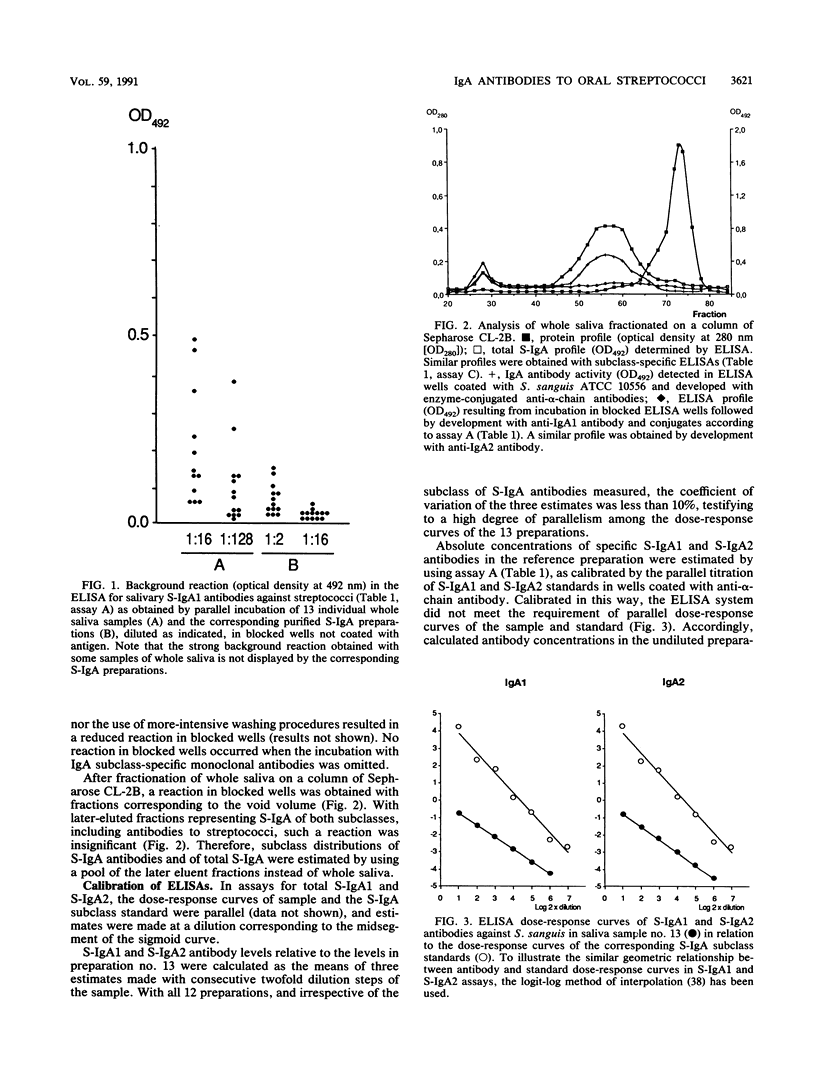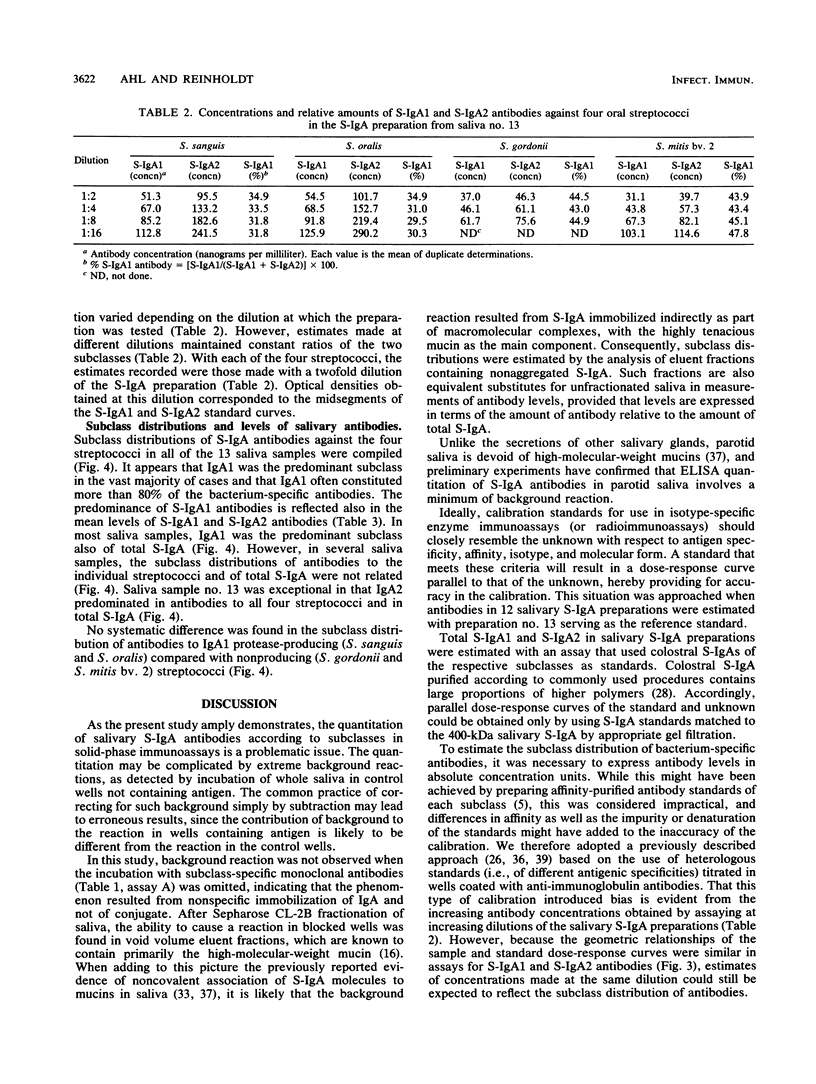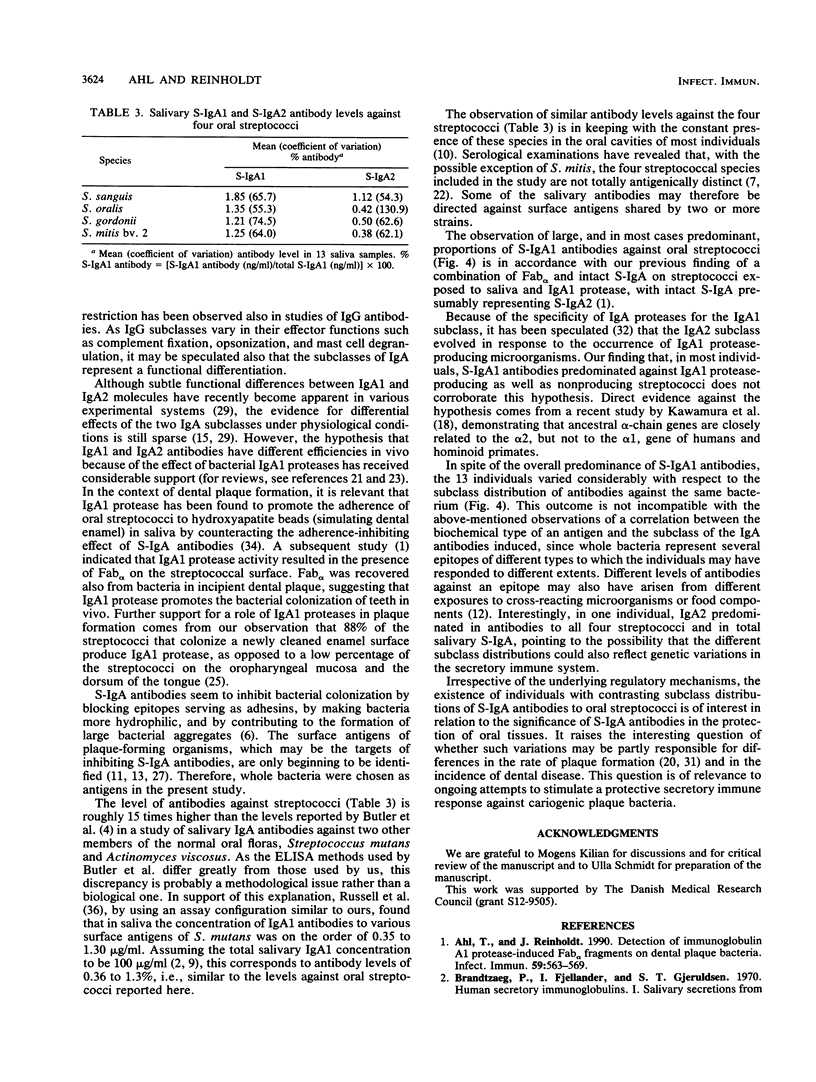Abstract
The ability of specific secretory immunoglobulin A (S-IgA) antibodies to inhibit bacterial colonization of mucosal surfaces may be neutralized by the activity of bacterial IgA1 proteases. Because of the resistance of the IgA2 subclass to these enzymes, the biological effect of IgA1 proteases in vivo may depend on the subclass distribution of the bacterium-specific antibodies. We have estimated the subclass distribution of S-IgA antibodies in saliva samples from 13 individuals against IgA1 protease-producing (Streptococcus sanguis and Streptococcus oralis) and nonproducing (Streptococcus gordonii and Streptococcus mitis bv. 2) oral streptococci. IgA1 was found to be the predominant subclass of antibodies against these four bacteria in most of the saliva samples, corroborating previous data suggesting a role of IgA1 proteases in plaque formation. However, variation in the subclass distribution of S-IgA antibodies against the same strain was observed. In one individual, IgA2 was the predominant subclass of antibodies against all four streptococci and of total salivary S-IgA, pointing to the possible significance of genetic variations. The study also addresses methodological problems related to the quantitation of salivary antibodies by solid-phase immunoassays.
Full text
PDF






Selected References
These references are in PubMed. This may not be the complete list of references from this article.
- Ahl T., Reinholdt J. Detection of immunoglobulin A1 protease-induced Fab alpha fragments on dental plaque bacteria. Infect Immun. 1991 Feb;59(2):563–569. doi: 10.1128/iai.59.2.563-569.1991. [DOI] [PMC free article] [PubMed] [Google Scholar]
- Brandtzaeg P., Fjellanger I., Gjeruldsen S. T. Human secretory immunoglobulins. I. Salivary secretions from individuals with normal or low levels of serum immunoglobulins. Scand J Haematol Suppl. 1970;12:3–83. [PubMed] [Google Scholar]
- Brown T. A., Mestecky J. Immunoglobulin A subclass distribution of naturally occurring salivary antibodies to microbial antigens. Infect Immun. 1985 Aug;49(2):459–462. doi: 10.1128/iai.49.2.459-462.1985. [DOI] [PMC free article] [PubMed] [Google Scholar]
- Butler J. E., Spradling J. E., Peterman J. H., Joshi K. S., Satam M., Challacombe S. J. Humoral immunity in root caries in an elderly population. 1. Oral Microbiol Immunol. 1990 Apr;5(2):98–107. doi: 10.1111/j.1399-302x.1990.tb00236.x. [DOI] [PubMed] [Google Scholar]
- Challacombe S. J., Bergmeier L. A., Czerkinsky C., Rees A. S. Natural antibodies in man to Streptococcus mutans: specificity and quantification. Immunology. 1984 May;52(1):143–150. [PMC free article] [PubMed] [Google Scholar]
- Childers N. K., Bruce M. G., McGhee J. R. Molecular mechanisms of immunoglobulin A defense. Annu Rev Microbiol. 1989;43:503–536. doi: 10.1146/annurev.mi.43.100189.002443. [DOI] [PubMed] [Google Scholar]
- Cole R. M., Calandra G. B., Huff E., Nugent K. M. Attributes of potential utility in differentiating among "group H" streptococci or Streptococcus sanguis. J Dent Res. 1976 Jan;55:A142–A153. doi: 10.1177/002203457605500106011. [DOI] [PubMed] [Google Scholar]
- Czerkinsky C., Rees A. S., Bergmeier L. A., Challacombe S. J. The detection and specificity of class specific antibodies to whole bacterial cells using a solid phase radioimmunoassay. Clin Exp Immunol. 1983 Jul;53(1):192–200. [PMC free article] [PubMed] [Google Scholar]
- Delacroix D. L., Dive C., Rambaud J. C., Vaerman J. P. IgA subclasses in various secretions and in serum. Immunology. 1982 Oct;47(2):383–385. [PMC free article] [PubMed] [Google Scholar]
- Frandsen E. V., Pedrazzoli V., Kilian M. Ecology of viridans streptococci in the oral cavity and pharynx. Oral Microbiol Immunol. 1991 Jun;6(3):129–133. doi: 10.1111/j.1399-302x.1991.tb00466.x. [DOI] [PubMed] [Google Scholar]
- Ganeshkumar N., Hannam P. M., Kolenbrander P. E., McBride B. C. Nucleotide sequence of a gene coding for a saliva-binding protein (SsaB) from Streptococcus sanguis 12 and possible role of the protein in coaggregation with actinomyces. Infect Immun. 1991 Mar;59(3):1093–1099. doi: 10.1128/iai.59.3.1093-1099.1991. [DOI] [PMC free article] [PubMed] [Google Scholar]
- Gibbons R. J., Dankers I. Lectin-like constituents of foods which react with components of serum, saliva, and Streptococcus mutans. Appl Environ Microbiol. 1981 Apr;41(4):880–888. doi: 10.1128/aem.41.4.880-888.1981. [DOI] [PMC free article] [PubMed] [Google Scholar]
- Gibbons R. J., Fitzgerald R. J. Dextran-induced agglutination of Streptococcus mutans, and its potential role in the formation of microbial dental plaques. J Bacteriol. 1969 May;98(2):341–346. doi: 10.1128/jb.98.2.341-346.1969. [DOI] [PMC free article] [PubMed] [Google Scholar]
- Gregory R. L., Kindle J. C., Hobbs L. C., Filler S. J., Malmstrom H. S. Function of anti-Streptococcus mutans antibodies: inhibition of virulence factors and enzyme neutralization. Oral Microbiol Immunol. 1990 Aug;5(4):181–188. doi: 10.1111/j.1399-302x.1990.tb00643.x. [DOI] [PubMed] [Google Scholar]
- Hay D. I., Gibbons R. J., Spinell D. M. Characteristics of some high molecular weight constituents with bacterial aggregating activity from whole saliva and dental plaque. Caries Res. 1971;5(2):111–123. doi: 10.1159/000259739. [DOI] [PubMed] [Google Scholar]
- Kawamura S., Omoto K., Ueda S. Evolutionary hypervariability in the hinge region of the immunoglobulin alpha gene. J Mol Biol. 1990 Sep 20;215(2):201–206. doi: 10.1016/S0022-2836(05)80336-5. [DOI] [PubMed] [Google Scholar]
- Kilian M., Holmgren K. Ecology and nature of immunoglobulin A1 protease-producing streptococci in the human oral cavity and pharynx. Infect Immun. 1981 Mar;31(3):868–873. doi: 10.1128/iai.31.3.868-873.1981. [DOI] [PMC free article] [PubMed] [Google Scholar]
- Kilian M., Larsen M. J., Fejerskov O., Thylstrup A. Effects of fluoride on the initial colonization of teeth in vivo. Caries Res. 1979;13(6):319–329. doi: 10.1159/000260422. [DOI] [PubMed] [Google Scholar]
- Kilian M., Mestecky J., Russell M. W. Defense mechanisms involving Fc-dependent functions of immunoglobulin A and their subversion by bacterial immunoglobulin A proteases. Microbiol Rev. 1988 Jun;52(2):296–303. doi: 10.1128/mr.52.2.296-303.1988. [DOI] [PMC free article] [PubMed] [Google Scholar]
- Kilian M., Reinholdt J., Mortensen S. B., Sørensen C. H. Perturbation of mucosal immune defence mechanisms by bacterial IgA proteases. Bull Eur Physiopathol Respir. 1983 Mar-Apr;19(2):99–104. [PubMed] [Google Scholar]
- Kilian M., Reinholdt J., Nyvad B., Frandsen E. V., Mikkelsen L. IgA1 proteases of oral streptococci: ecological aspects. Immunol Invest. 1989 Jan-May;18(1-4):161–170. doi: 10.3109/08820138909112235. [DOI] [PubMed] [Google Scholar]
- Mestecky J., Kilian M. Immunoglobulin A (IgA). Methods Enzymol. 1985;116:37–75. doi: 10.1016/s0076-6879(85)16005-2. [DOI] [PubMed] [Google Scholar]
- Mestecky J., Russell M. W. IgA subclasses. Monogr Allergy. 1986;19:277–301. [PubMed] [Google Scholar]
- Mäkelä O., Péterfy F. Standard sera in solid-phase immunoassays. Eur J Immunol. 1983 Oct;13(10):815–819. doi: 10.1002/eji.1830131007. [DOI] [PubMed] [Google Scholar]
- Nyvad B., Kilian M. Microbiology of the early colonization of human enamel and root surfaces in vivo. Scand J Dent Res. 1987 Oct;95(5):369–380. doi: 10.1111/j.1600-0722.1987.tb01627.x. [DOI] [PubMed] [Google Scholar]
- Plaut A. G. The IgA1 proteases of pathogenic bacteria. Annu Rev Microbiol. 1983;37:603–622. doi: 10.1146/annurev.mi.37.100183.003131. [DOI] [PubMed] [Google Scholar]
- Reinholdt J., Kilian M. Interference of IgA protease with the effect of secretory IgA on adherence of oral streptococci to saliva-coated hydroxyapatite. J Dent Res. 1987 Feb;66(2):492–497. doi: 10.1177/00220345870660021801. [DOI] [PubMed] [Google Scholar]
- Reinholdt J., Krogh P., Holmstrup P. Degradation of IgA1, IgA2, and S-IgA by Candida and Torulopsis species. Acta Pathol Microbiol Immunol Scand C. 1987 Dec;95(6):265–274. doi: 10.1111/j.1699-0463.1987.tb00040.x. [DOI] [PubMed] [Google Scholar]
- Russell M. W., Brown T. A., Radl J., Haaijman J. J., Mestecky J. Assay of human IgA subclass antibodies in serum and secretions by means of monoclonal antibodies. J Immunol Methods. 1986 Feb 27;87(1):87–93. doi: 10.1016/0022-1759(86)90347-9. [DOI] [PubMed] [Google Scholar]
- Tabak L. A., Levine M. J., Mandel I. D., Ellison S. A. Role of salivary mucins in the protection of the oral cavity. J Oral Pathol. 1982 Feb;11(1):1–17. doi: 10.1111/j.1600-0714.1982.tb00138.x. [DOI] [PubMed] [Google Scholar]
- Zollinger W. D., Boslego J. W. A general approach to standardization of the solid-phase radioimmunoassay for quantitation of class-specific antibodies. J Immunol Methods. 1981;46(2):129–140. doi: 10.1016/0022-1759(81)90130-7. [DOI] [PubMed] [Google Scholar]


